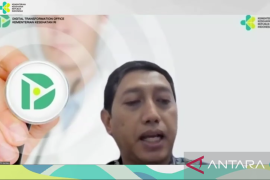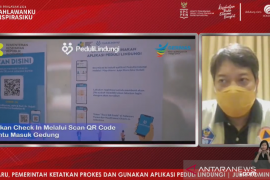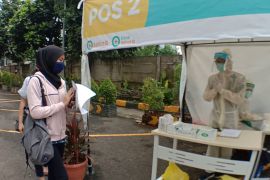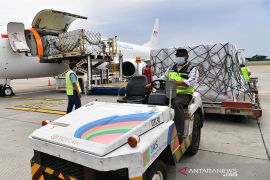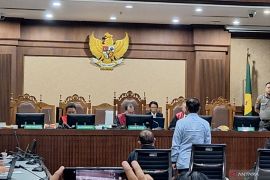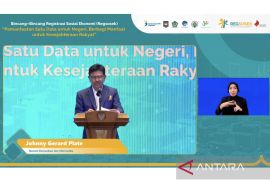The growth of our digital economy is so big. It really depends on the readiness of ICT infrastructure throughout Indonesia and also on digital talentJakarta (ANTARA) - The coronavirus pandemic that has been ongoing for more than two years, forcing almost all countries to adjust in many sectors in order to survive, including Indonesia, in utilizing technology.
Minister of Communication and Informatics, Johnny G. Plate, stated that one of the impacts brought by the pandemic was digitalization in helping the health sector.
One of the examples of technology utilization in Indonesia to respond to a pandemic is the PeduliLindungi application that is managed by the government. PeduliLindungi started as a tool to track the spread of COVID-19 in the community.
In its development, the platform developed a one-stop integrated service to deal with the pandemic. In addition to tracking, PeduliLindungi functions as a vaccination data collection tool and disseminates the latest information on travel regulations during the pandemic.
“I think all leaders in G20 already know our success in maintaining and controlling the pandemic, one of which is by technology utilization,” Plate remarked.
The use of digital technology in Indonesia did not actually occur because of the pandemic. However, this health crisis triggered faster technology adoption. Long before the pandemic, the government, through the Ministry of Communication and Informatics, had tried to build information and communication technology infrastructure to widen internet access to remote areas.
“While we were developing information and communications technology (ICT), the pandemic occurred. The pandemic forced us to accelerate our ICT development,” the minister added.
One of the examples of the ICT acceleration conducted by the Ministry of Communication and Information is the construction of ICT infrastructure for 3,200 public health centers (puskesmas), which earlier had no internet access, in three months in 2020.
If done according to the initial schedule, Plate says it will take about seven years to complete internet access for thousands of health service points in Indonesia. The ministry uses satellite technology to stream these points with the internet.
One of the impacts of the existence of the internet in health services is data collection for the COVID-19 vaccination program.
"These three months of work have helped Indonesia to resolve the COVID-19 pandemic through the use of digital technology, so that vaccinations, hospital data collection, medicine data collection, and the spread of COVID-19 in districts, villages, sub-districts, to the Puskesmas level can be monitored properly through the surveillance application that we provide, which is PeduliLindungi,” the minister remarked.
Digitizing health services
The pandemic has indeed encouraged all public services to be able to switch to digital technology, including health services. Remote health services are believed to become a solution to access health facilities in Indonesia.
"In principle, digital transformation in the health sector is needed by the global community. Indonesia is very fortunate to have a strong technology ecosystem that can be utilized as well as possible as an effort to support and bring access to health services closer to the community, including in the regions," Chairman of the Indonesian Doctors Association (IDI), Dr Moh. Adib Khumaidi, stated at the 2022 Nusantara Digitalization Expo and Summit.
Apart from COVID-19 handling, technology utilization in the health sector could help to accommodate community activities that had been hindered for the past two years due to the pandemic. During the pandemic, patients could access health services from a distance through an online consultation with doctors.
In addition to offering consultations with doctors remotely, digital health services that are integrated with pharmacies also help patients to access medicines.
Chairman of the Indonesian Pharmacists Association, Apt. Drs Nurul Falah Eddy Pariang, said the synergy of pharmacies with digital health services could provide access to qualified health services.
The expansion of the use of digital health services to the regions is also a manifestation of the government's commitment to accelerating the digital transformation process in Indonesian health services.
Economic benefits
The use of digital technology during the pandemic has proven not only to help health services but also the digital economy. Various surveys show that businesses, especially micro, small, and medium enterprises (MSMEs), are able to survive during the pandemic with their digital ecosystem.
Data from the Ministry of Cooperatives and Small and Medium Enterprises shows that 80 percent of the MSMEs connected to the digital ecosystem have better resilience during the pandemic.
As a result of the digital technology utilization, the digital economy in Indonesia is growing bigger, with the valuation estimated to reach US$70 billion by 2021, almost half, or 40 percent, of the digital economy in Southeast Asia.
By 2025, Indonesia's digital economy is projected to be worth US$146 billion. Its value is forecast to rise to US$315 billion by 2030.
"The growth of our digital economy is so big. It really depends on the readiness of ICT infrastructure throughout Indonesia and also on digital talent," Minister Plate stated.
Related news: Booster requirement for travel if COVID-19 keep increasing: Minister
He later noted that ICT infrastructure, technology utilization, digital economy, and digital talent cannot be separated. If combined together, they would bring technology benefits to Indonesia.
The Ministry of Communications and Informatics was also building ICT infrastructure to be more equitable and prepare Indonesian digital talents to be able to utilize technology.
ICT infrastructure development has been ongoing for the past few years, for instance, in 2019, Indonesia completed the construction of three Palapa Ring packages, the backbone network for ICT infrastructure in the form of deploying fiber optic cables.
In the second layer or middle mile, Indonesia had built fiber links, microwave links, and satellites to connect areas that are not covered by fiber optic cables, both on land and at sea.
The government is also currently preparing at least two multifunction satellites, each with a capacity of 150GB, namely SATRIA-1 and one backup satellite. This technology will be used to stream public facilities with the internet.
The development of this entire infrastructure aims to enable all people living in various regions in Indonesia to be connected to the 4G network. The network is currently the mainstay in Indonesian telecommunications, but it does not prevent the adoption of the latest technology.
Related news: Don't panic, task force tells people as Omicron subvariants emerge
While working on the 4G network across the country, the government is also gradually adopting the newest network, 5G, whose use is currently still limited.
At the downstream level, the ministry focuses on community readiness to use digital technology. In this case, the ministry conducts training, starting from the basic level with digital literacy activities, secondary intermediate level with training scholarships for high school and college graduates, and advanced level for policymakers.
"We want that the downstreaming of digital technology can benefit the surrounding community and our digital economy to grow bigger,” Plate noted.
The use of digital technology to emerge from the pandemic is a derivative of the discussion of three priority issues promoted by the G20 Presidency of Indonesia, specifically the global health architecture, digital and economic transformation, and the transition to sustainable energy.
Related news: Jakarta logs highest BA.4, BA.5 cases at 98: ministry
Related news: 143 BA.4, BA.5 cases detected in Indonesia: ministry
Translator: Natisha Andarningtyas, Resinta
Editor: Fardah Assegaf
Copyright © ANTARA 2022

